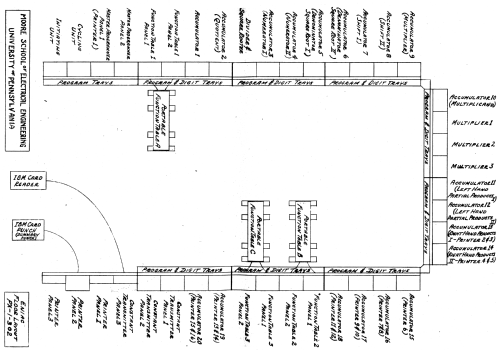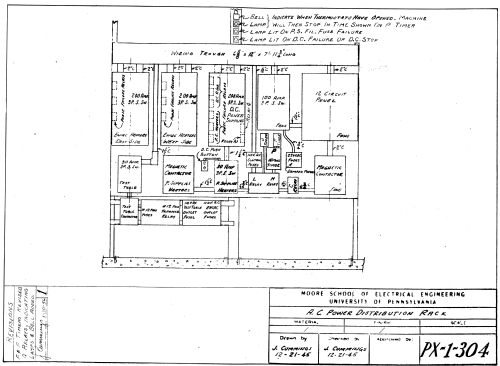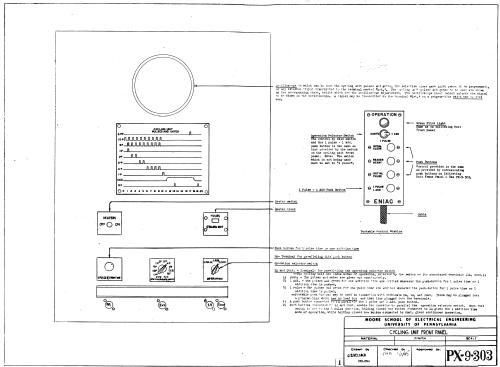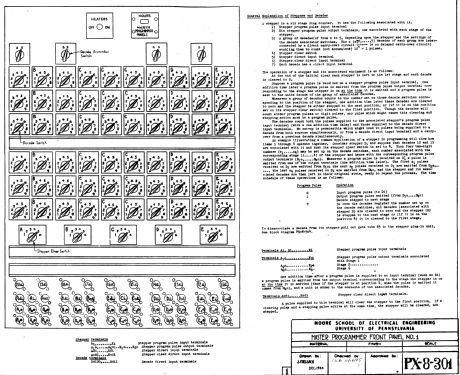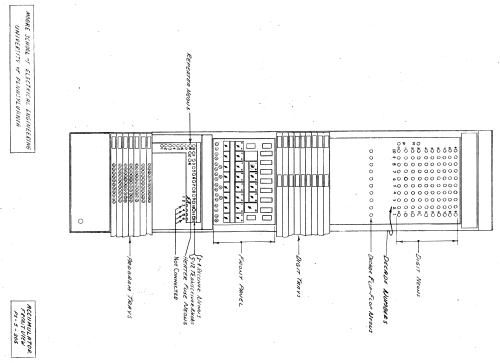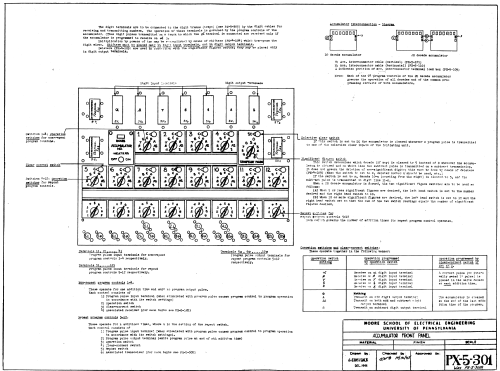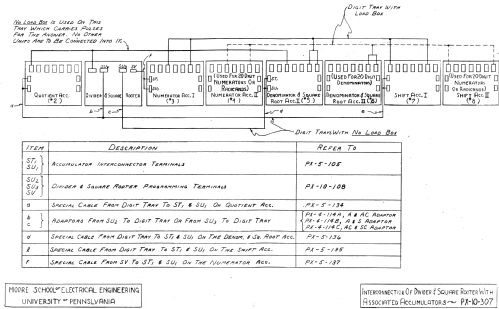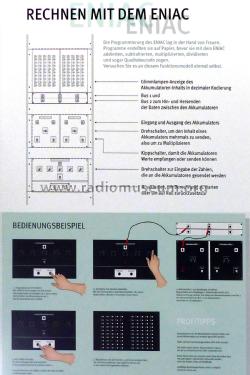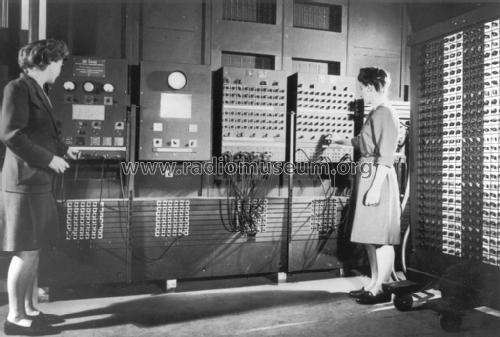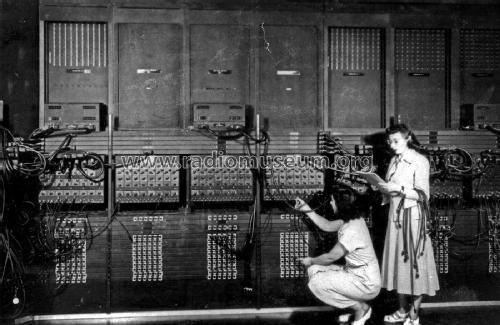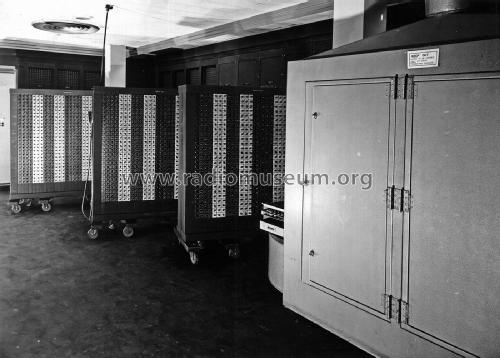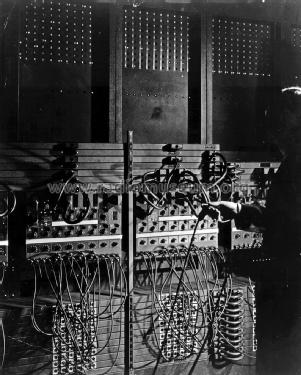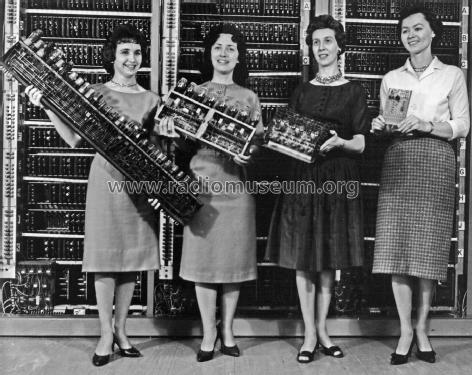ENIAC - Electronic Numerical Integrator And Computer
MILITARY U.S. (different makers for same model)
- Land
- USA
- Hersteller / Marke
- MILITARY U.S. (different makers for same model)
- Jahr
- 1946
- Kategorie
- Signal Processing and Computing
- Radiomuseum.org ID
- 278915
Klicken Sie auf den Schaltplanausschnitt, um diesen kostenlos als Dokument anzufordern.
- Anzahl Röhren
- 17468
- Wellenbereiche
- - ohne
- Lautsprecher
- - - Kein Ausgang für Schallwiedergabe.
- Material
- Metall, SICHTBARE RÖHREN
- von Radiomuseum.org
- Modell: ENIAC - Electronic Numerical Integrator And Computer - MILITARY U.S. different makers
- Form
- Rack
- Abmessungen (BHT)
- 30000 x 2400 x 900 mm / 1181.1 x 94.5 x 35.4 inch
- Bemerkung
-
The ENIAC was the first electronic digital universal computer built at Pennsylvania University in 1944-1946. Although ENIAC was designed and primarily used to calculate artillery firing tables for the United States Army's Ballistic Research Laboratory.
ENIAC contained 17,468 vacuum tubes, 7200 crystal diodes, 1500 relays, 70,000 resistors, 10,000 capacitors and approximately 5,000,000 hand-soldered joints.
ENIAC occupied 167m2 (1800 ft2) and consumed 150 kW of electricity.ENIAC used ten-position ring counters to store digits; each digit required 36 vacuum tubes, 10 of which were the dual triodes making up the flip-flops of the ring counter.
ENIAC had 20 ten-digit signed accumulators, which used ten's complement representation and could perform 5000 simple addition or subtraction operations between any of them and a source (e.g., another accumulator or a constant transmitter) every second. It was possible to connect several accumulators to run simultaneously, so the peak speed of operation was potentially much higher, due to parallel operation.
The other 9 units in ENIAC were the Initiating Unit (started and stopped the machine), the Cycling Unit (used for synchronizing the other units), the Master Programmer (controlled "loop" sequencing), the Reader (controlled an IBM punch-card reader), the Printer (controlled an IBM card punch), the Constant Transmitter and 3 function tables.The basic machine cycle was 200 microseconds (20 cycles of the 100 kHz clock in the cycling unit), or 5,000 cycles per second for operations on the 10-digit numbers. In one of these cycles, ENIAC could write a number to a register, read a number from a register, or add/subtract two numbers.
ENIAC used common octal-base radio tubes of the day; the decimal accumulators were made of 6SN7 flip-flops, while 6L7's, 6SJ7's, 6SA7's and 6AC7's were used in logic functions. Numerous 6L6's and 6V6's served as line drivers to drive pulses through cables between rack assemblies.
Several tubes burned out almost every day, leaving it nonfunctional about half the time. Special high-reliability tubes were not available until 1948. Most of these failures, however, occurred during the warm-up and cool-down periods, when the tube heaters and cathodes were under the most thermal stress. Engineers reduced ENIAC's tube failures to the more acceptable rate of one tube every two days. According to a 1989 interview with Eckert, "We had a tube fail about every two days and we could locate the problem within 15 minutes." In 1954, the longest continuous period of operation without a failure was 116 hours—close to five days.
ENIAC could be programmed to perform complex sequences of operations, including loops, branches, and subroutines. The task of taking a problem and mapping it onto the machine usually took weeks. After the program was figured out on paper, the process of getting the program into ENIAC by manipulating its switches and cables could take days.
ENIAC was formally accepted by the U.S. Army Ordnance Corps in July 1946. ENIAC was shut down on November 9, 1946 for a refurbishment and a memory upgrade, and was transferred to Aberdeen Proving Ground, Maryland in 1947. There, on July 29, 1947, it was turned on and was in continuous operation until 11:45 p.m. on October 2, 1955.
Pieces of ENIAC are held by Museums. See links below.
- Nettogewicht
- 27000 kg / 59471 lb 5.9 oz (59471.366 lb)
- Originalpreis
- 500,000.00 US-$
- Literaturnachweis
- Wikipedia
- Autor
- Modellseite von Heribert Jung angelegt. Siehe bei "Änderungsvorschlag" für weitere Mitarbeit.
- Weitere Modelle
-
Hier finden Sie 407 Modelle, davon 359 mit Bildern und 213 mit Schaltbildern.
Alle gelisteten Radios usw. von MILITARY U.S. (different makers for same model)
Museen
Das Modell ENIAC - Electronic Numerical Integrator And Computer ist in den folgenden Museen zu sehen.
- West Point Museum (USA)
- University of Pennsylvania (USA)
- Fort Sill - U.S. Army Field Artillery Museum (USA)
- Jean Jennings Bartik Computing Museum (USA)
- Heinz Nixdorf MuseumsForum HNF (D)
- Bradbury Science Museum (USA)
- Computer History Museum (USA)
- Smithsonian - National Museum of American History (USA)
- Science Museum London (GB)
